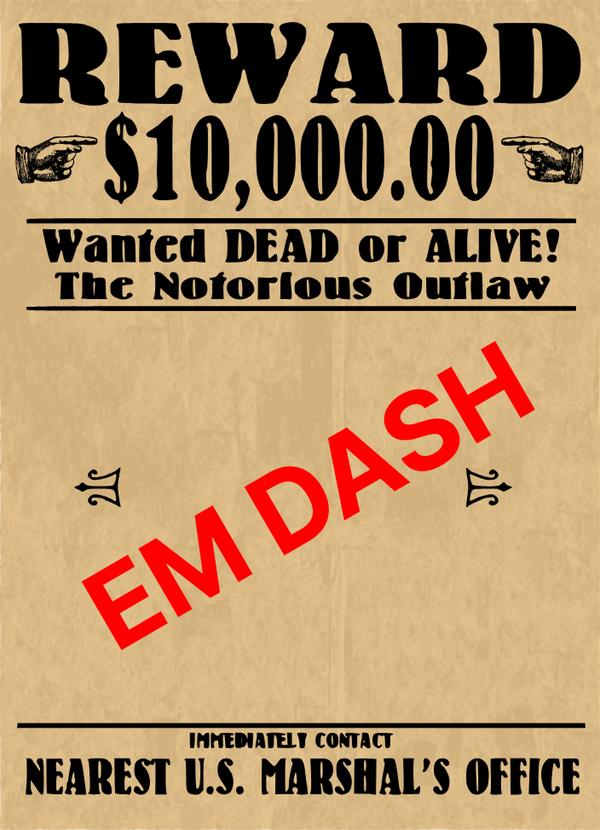Substack Promised a Better Internet—Then Gave Us TikTok

Lamenting The Enshittification of Substack
The wave of enshittification has finally reached the shores of Substack in the form of Substack Reels. Yes—the attention-machine has scaled the ivory tower of our once peaceful platform, taken a big dump, and in its wake has left us with an endless supply of vertical videos to swipe through. And for what? “Discoverability”? “Helping writers grow their audience and make a living”? At what cost?
Here, in my last piece on Substack, I’m going to explore what I think (as a software engineer and fan of open-source software) were the red flags, and maybe what we can do to avoid them in the future.
I Was In Love And I Didn’t Care Who Knew It
I’ve been following different Substack newsletters on and off since 2019; so, 6 of the 8 years that Substack has existed.
Me and my wife have paid money in order to follow and support writers on Substack. We are annoying. We talk about Substacks at the dinner table, on the front-porch, on car rides. We are those people.
The first account that I really engaged with was Elle Griffin’s, which is now called The Elysian. Back in 2019, she wrote, “Writing books isn’t a good idea” where she ruminated on the idea of “serializing novels” as a way to lower the barrier to entry to writing, and make writing novels more profitable.
That post got a lot of traction.
Brandon Sanderson (one of the most talented, living fantasy writers) joined in on the conversation, speaking about his lessons learned serializing his successful novels.
(He’s a very interesting case because he writes a whole series before he releases the first book!)
A little community started to form around Elle Griffin and the idea of “serializing a novel”. I even joined her Discord, where writers talked about serializing novels.
Later, Substack would actually pick up Elle Griffin as a, sort of, Substack ambassador. I thought that was pretty cool.
All that to say, I was a happy Substack user.
I was consuming good content and I was impressed with the community and the platform that had been built.
I was so overjoyed that I went to Twitter and relayed my feelings to the whole world—

Like Buddy the Elf, I was in love and I didn’t care who knew it.
Bad Omen(s)
Maybe I was blinded by my joy. But, looking back, there were a lot of red flags.
Their heavy focus on their native iOS and Android apps, the continued “improvement” of the discovery algorithm, the community grumbling about bad customer service,…
But I want to focus on just two, particular bad omens:
- The Ghost Twitter Fight (December, 2022)
- The Substack Notes Launch (April 2023)
1. The Ghost Twitter Fight
In my opinion, Substack committed a grievous sin in December 2022 when they pissed off the open source community.
This unfolded as a brief, mostly well-mannered Twitter kerfuffle started by John O’Nolan, the founder and CEO of Ghost (an open-source blogging platform).
I’ll try and summarize.
John O’Nolan came out with the news that “Substack is powered by Ghost”.
John didn’t discover this by conversations with the Substack team, but by doing his own investigation.
In the Twitter thread, he highlights that the template used on the Free Press’s Substack was a Ghost template. He then goes down a bit of a rabbit hole exploring other ways they’re using Ghost’s code.
Soon after, Chris Best, Substack Co-Founder, responds in a thread of his own saying that there are some “serious misunderstandings”.
Chris rebuts a few of John’s points, arguing that Substack is in-fact not powered by Ghost, but instead, that Substack developers “built [their] own theming API that’s compatible with themes built for Ghost”.
Chris even notes—

There are some more technical details, but they’re pretty boring (JavaScript package registries, etc.).
Chris Best concludes that they (Substack) were inspired by and appreciate Ghost’s contributions to open-source, but that their usage is completely compliant.
Chris ends his thread with an olive branch:

And I want to highlight this—
“In our minds, we’re on the same side of an important battle for a better internet.”
This has been one of Substack’s mottos—a battle for a better internet.
For a long time I wanted to believe Chris, and the team. I really did.
But anyways, let’s continue to our next bad omen.
Four months later, Substack Notes came out.
2. The Substack Notes Launch
The Substack “Notes” feature launched on April 5th, 2022 and was made available to all Substack users on April 11th (just about two years ago, exactly, as of this writing).
They had big goals, and a lot of flowery language in their blogpost to help tame people’s opinion—like how they’re still not participating in the “attention economy”, and how they’re different than ad-based platforms—they’re subscription based.
They remind us of their origin:
“…we set about building a system that fosters deep connections and quality over shallow engagement and dopamine hacks”
I didn’t know it at the time, but this was the beginning of the end. Cue the real lamentations.
Seven months later (November 3rd, 2022) Substack released the “Chat” feature.
“Chat is a community space reimagined specifically for writers and creators— it’s like having your own private social network where you make the rules.”
All the while, they’d been iterating on their discovery engine. And they’re quite happy with it, as you can see from this LinkedIn post in which they’re patting themselves on the back:
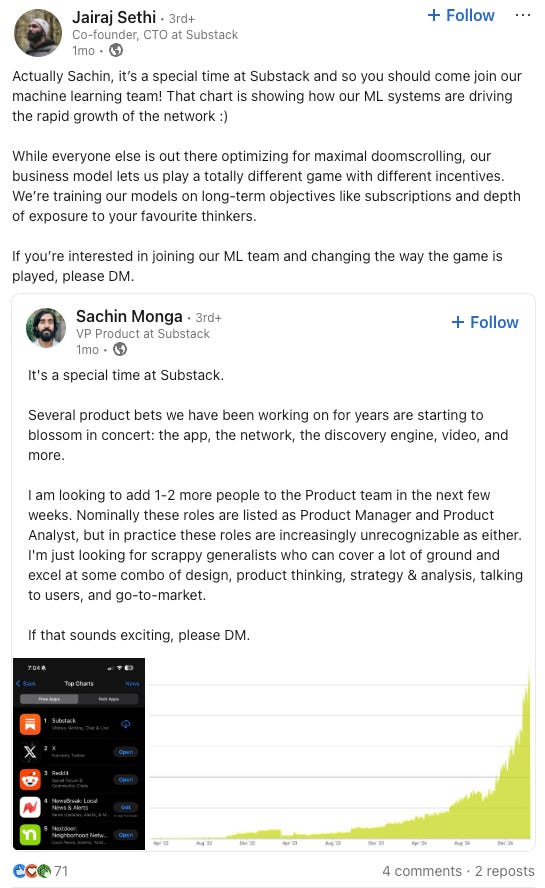
The Straw That Broke The Camel’s Back
If Substack’s “battle for a better internet” started with—
We started Substack in 2017 because we wanted the internet to be better for writers and readers. We were dismayed with the clickbait and content farms, the listicles and liars, the cheap outrage and culture wars. We thought there could be something better if writers and readers were given more control and treated as a higher priority than advertisers, and if culture makers could find financial dignity without needing to sublimate themselves to attention games and corporate marketing budgets. “We believe that what you read matters,” we said, and we meant it.
—then it ended with Notes, Chat, and now Substack Reels.
Substack has lost the battle for a better internet.
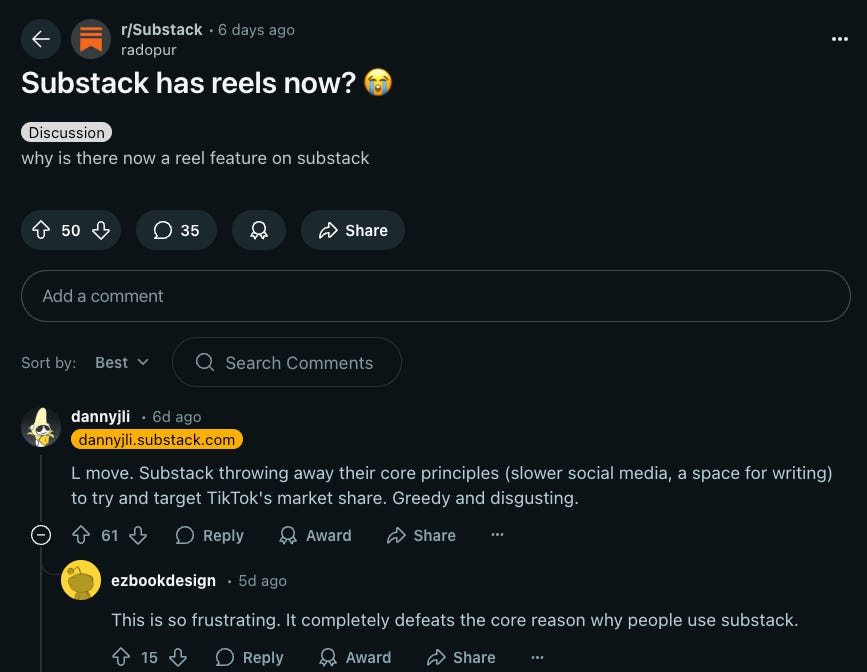
Like many others, I thought this was a joke at first. But no, it’s very real. I should have known better.
And like the Notes and Chat before it, this new Reel feature was released in the name of discoverability and helping writers make money.
There's been a lot of stir and unrest in the aftermath of Reels showing up in the Substack app. I posted a screenshot from Reddit, but some of my favorite engagements are coming from Substack itself.
Here’s my favorite interaction that I’ve come across, featuring Chris Best, Co-Founder of Substack.
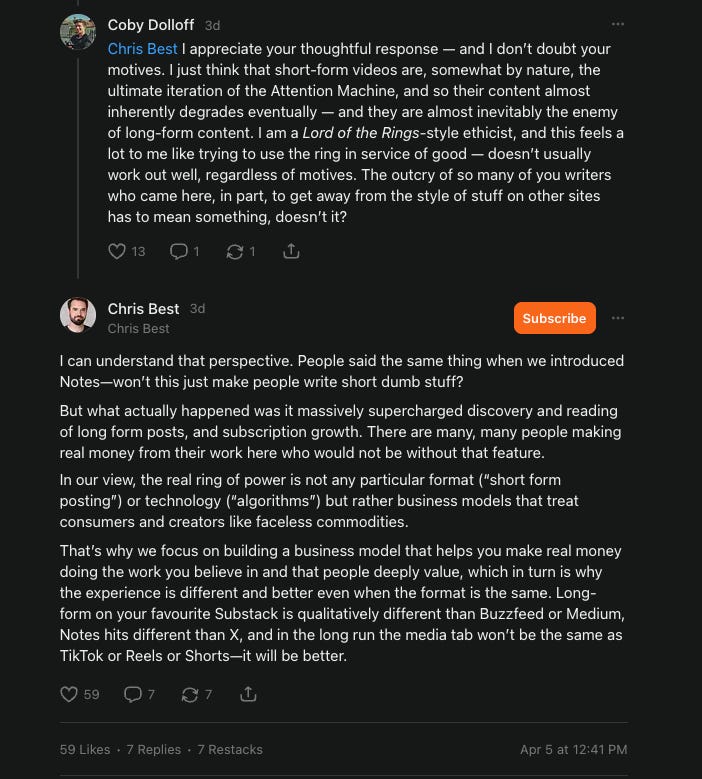
To summarize, Coby Dolloff compares Substack’s use of endless, vertical video swiping (Reels) to the idea of trying to use the One Ring (as in, the One ring to rule them all… you know the rest) in service of good. It’s impossible! Even with the best of motives, it’s impossible to promote good with the ring (Reels).
Good on you, Coby Dolloff. Good on you.
Chris Best tries to defend the decision. But it’s pretty empty. His mind has already been warped by the ring. I guess he’s sort of a Gollum character in this metaphor?
The New Substack Writer
Of all the recent mistakes that Substack has made, the one I find most hypocritical is at the core of the platform—the writer experience.
It’s my interpretation that Substack is making less and less of an effort to promote “a better internet”. Okay. But, they do continue to claim that they’re helping writers.
I.e., Chris Best posted this —
In our view, the real ring of power is not any particular format ("short form posting") or technology ("algorithms") but rather business models that treat consumers and creators like faceless commodities.
Well, let's look at the archetypal “Substack Writer” nowadays. What's their experience like? How do they fit into the world of Notes, Chat, Video, Live Streaming, and Reels?
For example, here’s a recent Reddit thread started by a Substack writer.
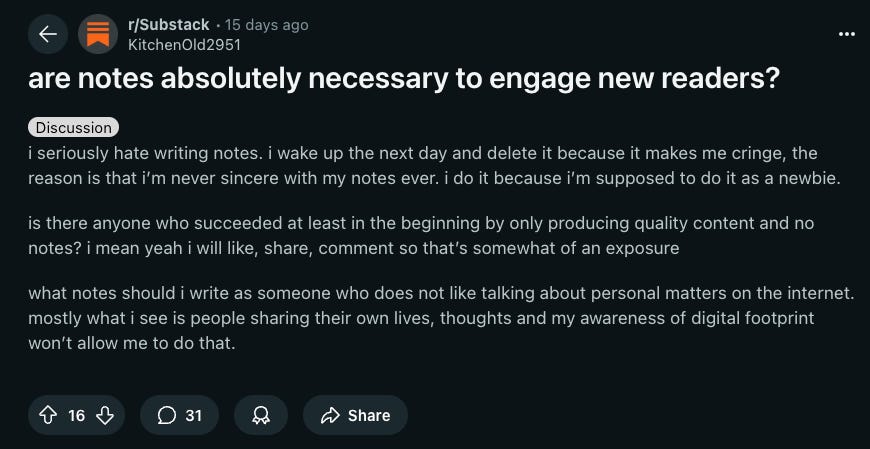
With each new feature that Substack adds—each new way of “engaging with your audience”—writers that want to maximize their “discoverability” are funneled into more stuff and less writing.
So their experience goes something like this–
They start posting notes, even though they think it’s cringe. After a while they open a chat to grow their community. But then they need to moderate their chat, or have community members moderate the chat—otherwise it gets a little weird.
Pretty soon, they’re doing live streams and collaborating with other Substack influencers, and making Substack Reels from their podcast recording sesh, because that’s now the recommended way to grow your newsletter.
And now tell me how are they not being treated like faceless commodities? I’m confused—do the writers like this? Do the readers? Are people happy with the new Reels tab on the Substack app? People came to Substack in order to write, and because they were tired of the other stuff. What changed?
What are the pressures being exerted on Substack out of which we get these features? Are these features really for the writers?
I understand that investors are happy, and the new features makes numbers go up, discovery metrics go up, but at what cost????
By the way, this is the meme-ing that Chris Best did, in response to our friend, Coby Dolloff (the one that does not like Reels).
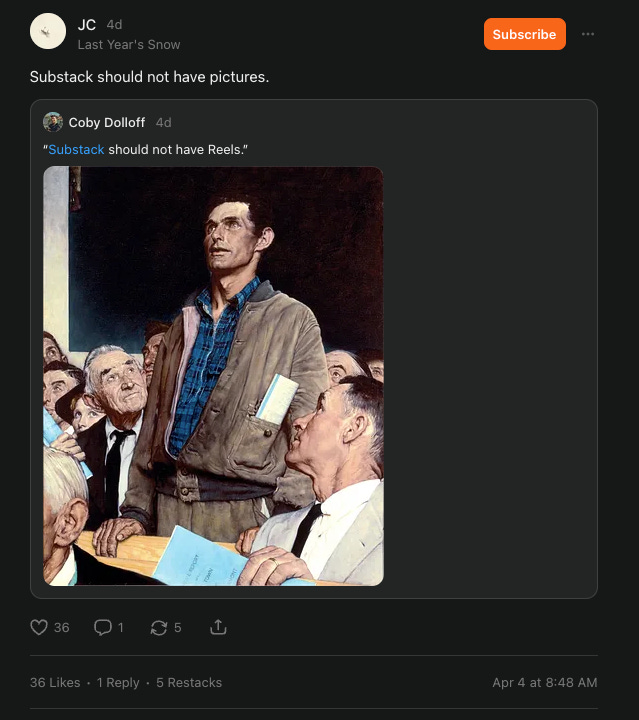
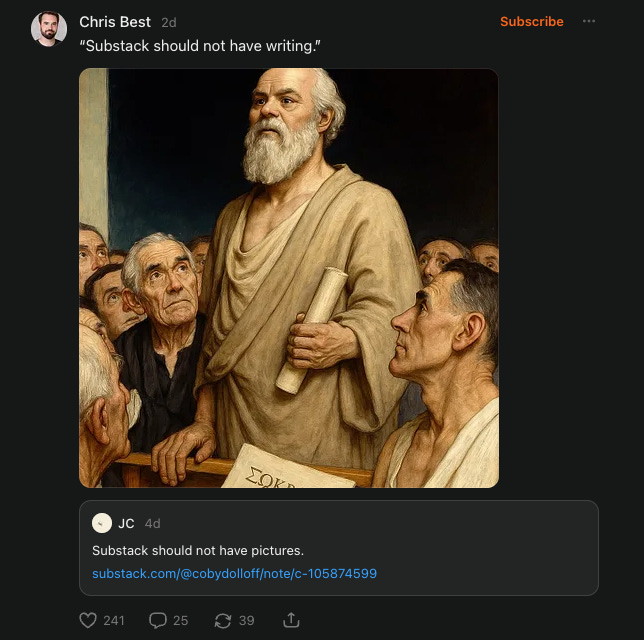
Again, these were the words from the launch of Notes—the very feature on which Chris Best is doing this meme-ing, at the expense of his Substack user:
So we set about building a system that fosters deep connections and quality over shallow engagement and dopamine hacks.
Ghost
Finally, I land on Ghost.
From their comparison-to-Substack page—
“Ghost is a more powerful, independent alternative to Substack with zero transaction fees.”
The one drawback is that Ghost does charge a $9/month fee if you host it through them.
But I went ahead and signed up for Ghost Pro, and found that setting up a $9/month Ghost blog was just as easy as setting up a Substack, and I love that they don’t take 10% of the revenue like Substack does.
Not that I have any paid subscribers, anyway. But, at least I know Ghost wouldn’t make more money if I did have paid subs. Because they don’t take a 10% cut, I find peace in the fact that Ghost doesn’t have the same pressures to grow in attention and revenue. To quote Chris Best, it’s less likely that I’ll become a “faceless commodity” if I do open paid subscriptions.
I also found that Ghost’s editor was much, much more feature rich (even though I like the simplicity of Substack and I understand what they’re going for—at the same time, I’ve been writing about lack of customer support. and lack of styling for software developers).
On that Ghost vs Substack comparison page there are also clear instructions on how to migrate from Substack to Ghost. I did it last night and it was great.
If you’re a bigger publication, there will probably be some migration pains. For example, the migration doesn’t remove the “Subscribe to [MY PUBLICATION HERE]” text (from Subscribe buttons) from all of your posts—you’ll have to clean that up manually. But if you have a big following and/or lots of posts, I suggest reaching out to Ghost’s concierge service here.
And I recommend that all Substack writers—particularly those with paid subscribers—do the same and move their posts and subscribers to Ghost—a mature, open-source blogging platform which is still fighting the good fight for a better internet.
Substack lost the battle, but the war rages on.
Signing off!!!
Nick / Slam Dunk Software


